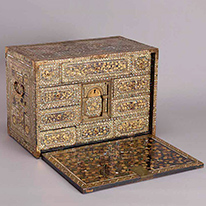Past Exhibitions
- Japanese Lacquers in the Age of Discovery
- December 13, 2016 - January 29, 2017
In the fifteenth century, Asia’s seas were filled with small trade ships that moved among port cities busily trading their wares: perfumes, silk textiles, copper, silver, sulfur, and other goods. It was into this environment that large Western ships arrived. By the middle of the sixteenth century, the Europeans had reached Japan, where they first discovered the Japanese art of makie. When an object is coated with the sap of the lacquer tree, it becomes extremely tough and durable, resistant to salts, acids, and alcohol. The early Europeans marveled that such lacquerwares could withstand hot water without cracking, and they loved their makie designs made with sprinkled gold powder. Soon makie lacquers had become a popular trade item. In accordance with the tastes of their new Western consumers, makie artists added elements such as inlaid mother-of-pearl and ray skin into their sprinkled gold designs. Some of the shell inlay was influenced by Indian mother-of-pearl techniques, while the ray skin was imported from Siam. The exotic Japanese wares known today as Nanban (“Southern Barbarian”) lacquers were born out of the international environment of their day.












